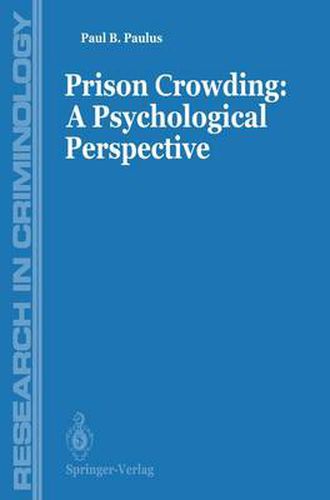Readings Newsletter
Become a Readings Member to make your shopping experience even easier.
Sign in or sign up for free!
You’re not far away from qualifying for FREE standard shipping within Australia
You’ve qualified for FREE standard shipping within Australia
The cart is loading…






This title is printed to order. This book may have been self-published. If so, we cannot guarantee the quality of the content. In the main most books will have gone through the editing process however some may not. We therefore suggest that you be aware of this before ordering this book. If in doubt check either the author or publisher’s details as we are unable to accept any returns unless they are faulty. Please contact us if you have any questions.
This volume is a summary of a 1S-year effort to determine the effects of prison crowding and their relationship to the broader realm of crowding phenomena and theories. Although the writing of this volume was for the most part a solitary effort, the data and ideas it is based on were mostly the result of a collaborative effort with Verne Cox and Garvin McCain. Their schedules limited their ability to contribute to this volume, but they provided much constructive feedback and assistance. Cox also wrote a preliminary draft of Chapter 3, and both McCain and Cox made major contributions to Chapter S and assisted with several other chapters. I am greatly indebted to these two fine scholars for their efforts and support over the course of our joint research endeavors. In recognition of this fact, the pronoun we is used throughout this volume. This research would not have been possible without the cooperation and support of thousands of inmates and hundreds of prison officials. The un conditional support throughout the project from Director Norman Carlson and former regional research director Jerome Mabli, both of the Federal Bureau of Prisons, is also greatly appreciated. Thanks are due to the National Institute of Justice for financial support during various phases of this project. The support of John Spevacek of the Institute was indispens able. Funds were also provided by the Hogg Foundation, U. S. Department of Justice-Civil Rights Division, and the University of Texas at Arlington.
$9.00 standard shipping within Australia
FREE standard shipping within Australia for orders over $100.00
Express & International shipping calculated at checkout
This title is printed to order. This book may have been self-published. If so, we cannot guarantee the quality of the content. In the main most books will have gone through the editing process however some may not. We therefore suggest that you be aware of this before ordering this book. If in doubt check either the author or publisher’s details as we are unable to accept any returns unless they are faulty. Please contact us if you have any questions.
This volume is a summary of a 1S-year effort to determine the effects of prison crowding and their relationship to the broader realm of crowding phenomena and theories. Although the writing of this volume was for the most part a solitary effort, the data and ideas it is based on were mostly the result of a collaborative effort with Verne Cox and Garvin McCain. Their schedules limited their ability to contribute to this volume, but they provided much constructive feedback and assistance. Cox also wrote a preliminary draft of Chapter 3, and both McCain and Cox made major contributions to Chapter S and assisted with several other chapters. I am greatly indebted to these two fine scholars for their efforts and support over the course of our joint research endeavors. In recognition of this fact, the pronoun we is used throughout this volume. This research would not have been possible without the cooperation and support of thousands of inmates and hundreds of prison officials. The un conditional support throughout the project from Director Norman Carlson and former regional research director Jerome Mabli, both of the Federal Bureau of Prisons, is also greatly appreciated. Thanks are due to the National Institute of Justice for financial support during various phases of this project. The support of John Spevacek of the Institute was indispens able. Funds were also provided by the Hogg Foundation, U. S. Department of Justice-Civil Rights Division, and the University of Texas at Arlington.